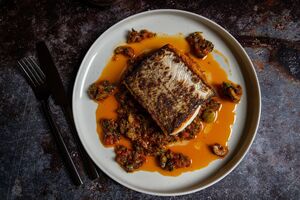Swede and potato cakes with black pepper and cream sauce
These tender potato cakes have a hint of mustard and agar flakes for enhanced flavour - they pair beautifully with seasoned cream

SERVES
8
PEOPLE
PREP TIME
15
MINUTES
COOKING TIME
60
MINUTES
Ingredients
500g swede
300g potatoes
25g butter
1tsp Maldon salt
2 tsp agar flakes
1 egg yolk
1 tbsp parmesan, freshly grated
1 tsp spring onion, chopped
flour, for coating
olive oil, for frying
For the sauce:
250ml double cream
2 tsp black peppercorns, cracked or coarsely crushed
salt, to taste
30g butter
2 tsp smooth Dijon mustard
watercress sprigs, to garnish
Method
Preheat oven to 160°C.
Peel the swede and potatoes and cut them into chunks. Melt the butter in a lidded, roomy pot over a low heat and add the swede, potatoes and salt. Stir together and gently cook for about 5 minutes – more than anything else, this is to coat the vegetables with butter and to get the pot hot. Put on the lid, transfer to oven and cook for about 45 minutes to 1 hour until the vegetables are tender.
Now return the pot to a very low heat on top of the stove and stir the vegetables around to try and rid them of extra moisture; it does not matter if they colour very slightly, or if they break a little, either. Mash the vegetables coarsely and, if uncertain about wetness, now is the time to sprinkle over the agar flakes and mix them in.
Tip into a bowl and allow to cool completely before mixing in the egg yolk, Parmesan and spring onion. Spread on a flat tray and put in the fridge to firm up. Meanwhile make the simple sauce by whisk all the ingredients together in a small pan and bring to a simmer. Cook until slightly thickened and pour into a hot jug or sauceboat. Form the swede and potato mash into 8 small cakes and roll in flour to coat all over.
Heat a little olive oil in a frying pan and gently fry the swede and potato cakes on both sides until golden; drain on kitchen paper. Serve and garnish with sprightly sprigs of chilled watercress, if desired, handing the sauce around separately.
This recipe is from Simon Hopkinson.




